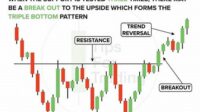In forex trading, support and resistance points are crucial technical analysis tools that help traders identify potential price reversals. Mastering these points can lead to optimal profit by enabling traders to make informed decisions about when to enter and exit trades.
Support is a price level where a downtrend is likely to pause or reverse. Resistance is a price level where an uptrend is likely to pause or reverse. By identifying these points, traders can anticipate potential price movements and position themselves accordingly.
Mastering support and resistance points requires practice and experience. Traders need to be able to recognize these points on price charts and understand how they can be used to develop trading strategies. There are various technical indicators and chart patterns that can help traders identify support and resistance points, and these can be combined with other forms of technical analysis to improve trading accuracy.
Importance and Benefits of Mastering Support and Resistance Points
Mastering support and resistance points offers several important benefits for forex traders:
- Improved trade timing: By identifying support and resistance points, traders can better time their entries and exits, maximizing their profit potential.
- Reduced risk: Support and resistance points can help traders identify potential reversal points, allowing them to exit trades before significant losses occur.
- Increased confidence: Mastering support and resistance points can boost a trader’s confidence in their trading decisions, leading to more consistent profitability.
Conclusion
Mastering support and resistance points is an essential skill for any forex trader who wants to achieve optimal profit. By understanding these concepts and applying them to their trading strategies, traders can improve their chances of success in the forex market.
Mastering Support and Resistance Points in Forex Trading for Optimal Profit
Mastering support and resistance points is crucial for successful forex trading. These points provide valuable insights into potential price movements, enabling traders to make informed decisions and maximize their profits.
- Identification: Accurately identifying support and resistance points is the foundation for successful trading.
- Confirmation: Confirmation from multiple indicators or chart patterns enhances the reliability of support and resistance levels.
- Breakouts: Breakouts above resistance or below support can signal new trading opportunities with high profit potential.
- Retracements: Retracements towards support or resistance levels often provide opportunities for counter-trend trading.
- Risk Management: Support and resistance points help traders define stop-loss and take-profit levels, managing risk effectively.
These key aspects are interconnected and essential for mastering support and resistance points in forex trading. By understanding and applying these concepts, traders can improve their trading accuracy, increase their profit potential, and minimize their risks.
Identification
In the realm of forex trading, mastering support and resistance points is paramount for optimal profit. The ability to accurately identify these points lays the groundwork for successful trading by providing valuable insights into potential price movements.
-
Facet 1: Foundation for Decision-Making
Identifying support and resistance points equips traders with a solid basis for making informed trading decisions. By recognizing these levels, traders can determine potential areas where price reversals or continuations may occur, allowing them to plan their trades accordingly. -
Facet 2: Risk Management
Understanding support and resistance points is crucial for effective risk management. Traders can use these levels to set appropriate stop-loss orders, minimizing potential losses if the market moves against their positions. -
Facet 3: Trend Analysis
Support and resistance points provide valuable clues about the underlying trend of the market. By studying the interactions between price and these levels, traders can identify potential trend reversals or continuations, enabling them to align their trades with the market’s direction. -
Facet 4: Price Targets
Identifying support and resistance points helps traders establish realistic price targets for their trades. These levels can serve as potential profit targets or areas where traders may consider adjusting their positions.
In summary, accurately identifying support and resistance points is the cornerstone of mastering forex trading for optimal profit. It empowers traders with the knowledge and insights necessary to make informed decisions, manage risk effectively, analyze market trends, and set appropriate price targets.
Confirmation
In the realm of forex trading, confirmation plays a paramount role in mastering support and resistance points for optimal profit. Confirmation involves utilizing multiple indicators or chart patterns to corroborate the validity of identified support and resistance levels, enhancing the trader’s confidence in their trading decisions.
Consider the scenario where a trader identifies a potential support level using a simple moving average (SMA). To strengthen their conviction in this level, they seek confirmation from other indicators, such as the relative strength index (RSI) or stochastic oscillator. If these indicators also align with the identified support level, it significantly increases the probability of the price respecting this level and provides a stronger basis for making trading decisions.
Confirmation is particularly valuable in volatile market conditions, where false breakouts and whipsaws can mislead traders. By relying on multiple sources of confirmation, traders can filter out market noise and focus on more reliable trading opportunities. Moreover, confirmation helps traders avoid premature entries or exits, leading to improved risk management and increased profit potential.
In summary, confirmation is a crucial aspect of mastering support and resistance points in forex trading. By seeking confirmation from multiple indicators or chart patterns, traders enhance the reliability of their analysis, make more informed trading decisions, and ultimately increase their chances of achieving optimal profit in the forex market.
Breakouts
In the realm of forex trading, breakouts are significant events that occur when the price of a currency pair decisively surpasses a key support or resistance level. Mastering the ability to identify and trade breakouts can lead to substantial profit opportunities.
-
Facet 1: Identifying Breakout Opportunities
Breakout trading involves identifying areas where the price has been consolidating within a defined range, indicated by support and resistance levels. When the price breaks out of this range with sufficient momentum, it often signals a potential trend reversal or continuation, presenting traders with opportunities to enter or exit trades. -
Facet 2: Confirmation and Validation
While breakouts can provide strong trading signals, it’s crucial to seek confirmation before entering a trade. Traders can use additional technical indicators, such as moving averages, trendlines, or candlestick patterns, to confirm the validity of the breakout and increase the probability of a successful trade. -
Facet 3: Risk Management
Breakout trading involves a certain level of risk, and proper risk management strategies are essential. Traders should carefully consider their entry and exit points, as well as their stop-loss and take-profit levels, to minimize potential losses and maximize profits. -
Facet 4: Profit Potential
Breakouts often lead to significant price movements, providing traders with the opportunity to capture substantial profits. However, it’s important to remember that not all breakouts are successful, and traders should always exercise caution and manage their risk accordingly.
In summary, breakouts are an integral part of mastering support and resistance points in forex trading for optimal profit. By understanding how to identify, confirm, and trade breakouts, traders can enhance their ability to capitalize on market opportunities and increase their overall profitability.
Retracements
In the realm of forex trading, mastering support and resistance points is essential for optimal profit. Retracements, which are temporary price movements against the prevailing trend, offer valuable opportunities for counter-trend trading when they occur near support or resistance levels.
-
Facet 1: Identifying Retracement Opportunities
Retracements often manifest as price pullbacks towards previously established support or resistance levels. Traders can identify these opportunities by observing price action and utilizing technical indicators such as Fibonacci retracement levels. -
Facet 2: Counter-Trend Trading Strategies
Counter-trend trading involves taking positions against the prevailing market trend. When a retracement occurs near a support or resistance level, traders can enter trades in anticipation of a reversal or continuation of the primary trend. -
Facet 3: Risk Management
Counter-trend trading carries inherent risk, and proper risk management is crucial. Traders should carefully consider their entry and exit points, as well as their stop-loss and take-profit levels, to minimize potential losses. -
Facet 4: Profit Potential
Successful counter-trend trading can lead to substantial profits, especially when retracements occur at significant support or resistance levels. However, traders should always exercise caution and manage their risk accordingly.
In conclusion, understanding and exploiting retracements near support or resistance levels is an integral part of mastering support and resistance points in forex trading for optimal profit. By incorporating counter-trend trading strategies into their repertoire, traders can enhance their ability to capitalize on market opportunities and increase their overall profitability.
Risk Management
In the realm of forex trading, managing risk is paramount for preserving capital and maximizing profit potential. Support and resistance points play a crucial role in risk management by providing traders with clear guidelines for defining stop-loss and take-profit levels.
Stop-loss orders are designed to limit potential losses by automatically closing a trade when the price moves against the trader’s position. By placing a stop-loss order just below a support level, traders can minimize their risk if the price breaks below that level, indicating a potential trend reversal.
Take-profit orders, on the other hand, are used to lock in profits by automatically closing a trade when the price reaches a predetermined profit target. Traders can place a take-profit order just above a resistance level, ensuring they secure their profits if the price rallies to that level and reverses.
The effective use of support and resistance points for risk management not only protects traders from excessive losses but also allows them to maximize their profits by capturing favorable price movements. By defining clear stop-loss and take-profit levels based on these key price levels, traders can maintain a disciplined trading approach and increase their chances of long-term success in the forex market.
In conclusion, the ability to identify and utilize support and resistance points for risk management is an essential component of mastering forex trading for optimal profit. By incorporating these techniques into their trading strategies, traders can enhance their risk management capabilities, preserve their capital, and position themselves for greater profitability.
Master Support and Resistance Points for Forex Success
To master forex trading and maximize profits, traders must harness the power of support and resistance points. Here are assertive tips to guide you:
Tip 1: Identify High-Probability Levels
Focus on support and resistance levels formed at significant round numbers, moving averages, or Fibonacci levels. These levels often attract increased trading activity, making them more reliable and profitable to trade.
Tip 2: Seek Confirmation
Don’t rely solely on one support or resistance level. Look for confluence with other technical indicators or chart patterns. Multiple confirmations enhance the reliability of these levels and increase your trading confidence.
Tip 3: Trade Breakouts Wisely
Breakouts from strong support or resistance levels can signal new trends. However, wait for confirmation before entering a trade. False breakouts are common, so use stop-loss orders to limit risk.
Tip 4: Exploit Retracements
When prices retrace towards support or resistance, consider counter-trend trading. Enter trades in anticipation of a continuation of the primary trend. Retracements offer opportunities for favorable entries with reduced risk.
Tip 5: Manage Risk Effectively
Use support and resistance levels to define precise stop-loss and take-profit levels. This proactive approach minimizes losses and secures profits. Disciplined risk management is crucial for long-term trading success.
Tip 6: Combine with Other Strategies
Support and resistance points alone may not provide complete trading signals. Combine them with other technical analysis tools, such as trendlines, candlestick patterns, or oscillators, for a more comprehensive trading strategy.
Tip 7: Practice and Patience
Mastering support and resistance points requires practice and patience. Backtest your strategies on historical data and refine them over time. Remember, successful trading is a journey, not a destination.
By following these assertive tips, you can master support and resistance points and unlock the path to optimal profit in forex trading.







